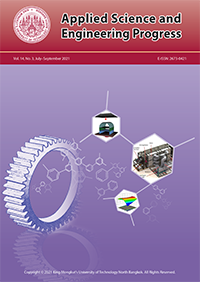Effect of Hemicellulase Enzyme in Flotation Deinking of Laser-printed Paper
Main Article Content
Abstract
Deinking is one of the most important steps in paper recycling process. Novel deinking method such as emzymatic deinking has grown more and more important in environmentally friendly paper recycling. The aim of this work was to investigate the effect of hemicellulase enzyme on the efficiency of ink removal from laser-printed paper in flotation deinking process. The influence on pulp and mechanical properties of deinked paper such as freeness, tensile index and tear index are also studied. The experiments performed at the dosages of hemicellulase enzyme from 0 to 0.15% with the concentration of nonionic surfactant (Tween-80) of 1.75% (Base on oven-dried weight of paper). The results obtained in this work revealed the enhancement of ink removal efficiency (11.3–95.3%), as indicated by the decreasing of the effective residual ink concentration (ERIC) as compared to non-deinked paper. Moreover, the results showed the improvement in freeness (3.7–13.2%), tensile index (5.2–18.1%), and tear index (19–25.6%) with respect to the control condition obtained with the absence of enzyme. These improvements were achieved considerably after flotation process but tended to drop down when the dosage of enzyme was too much. The maximum deinking efficiency (about 95%) was found at 0.1% hemicellulase enzyme (based on oven-dried weight of paper) which the mechanical properties after flotation deinking process increased about 25% and 18% in tear index and tensile index, respectively, as compared to control.
Article Details
References
[2] D. U. Lima, R. C. Oliviera, and M. S. Buckeridge, “Seed storage hemicelluloses as wet-end additives in papermaking,” Carbohydrate Polymers, vol. 52, no. 4, pp. 367–373, Jun. 2003.
[3] The Office of Industrial Economics, “e-Statistic,” 2019. [Online]. Available: https://indexes.oie. go.th/industrialStatistics1.aspx
[4] S. Zhenying, S. Dong, X. Cui, Y. Gao, J. Li, H. Wang, and S. N. Zhang, “Combined de-inking technology applied on laser printed paper,” Chemical Engineering and Processing: Process Intensification, vol. 48, no. 2, pp. 587–591, Feb. 2009.
[5] P. Bajpai, P. K. Bajpai, and R. Kondo, “Biotechnology for environmental protection in the pulp and paper industry,” Biofuture, vol. 2000, no. 196, p. 45, Jan. 2000.
[6] J. Behin and Sh. Vahed, “Effect of alkyl chain in alcohol deinking of recycled fibers by flotation process,” Colloids and Surfaces A: Physicochemical Engineering Aspects, vol. 297, no. 1, pp. 131–141, Apr. 2007.
[7] O. U. Heise, J. P. Unwin, J. H. Klungness, W. G. Fineran, M. Sykes, and S. Abubakr, “Industrial scaleup of enzyme-enhanced deinking of nonimpact printed toners,” Tappi Journal, vol. 79, no. 3, pp. 207–212, Mar. 1996.
[8] D. E. Tsatsis, D. K. Papachristos, K. A. Valta, A. G. Vlyssides, and D. G. Economides, “Enzymatic deinking for recycling of office waste paper,” Journal of Environmental Chemical Engineering, vol. 5, no. 2, pp. 1744–1753, Apr. 2017.
[9] H. Pala, M. Mota, and F. M. Gama, “Enzymatic versus chemical deinking of non-impact ink printed paper,” Journal of Biotechnology, vol. 108, no. 1, pp. 79–89, Feb. 2004.
[10] Y. Zhao, Y. Deng, and J. Y. Zhu, “Roles of surfactants in flotation deinking,” Progress in Paper Recycling, vol. 14, no. 1, pp. 41–45, Nov. 2004.
[11] J. K. Borchardt, “The use of surfactants in deinking paper for paper recycling,” Current Opinion in Colloid & Interface Science, vol. 2, no. 4, pp. 402–408, Aug. 1997.
[12] P. Chandranupap and P. Chandranupap, “Enzymatic deinking of xerographic waste paper with nonionic surfactant,” Applied Science and Engineering Progress, vol. 13, no. 2, pp. 136–145, 2020.
[13] B. Arechabala, C. Coiffard, P. Rivalland, L. J. M. Coiffard, and Y. D. Roeck-Holtzhauzer, “Comparison of cytotoxicity of various surfactants tested on normal human fibroblast cultures using the neutral red test, MTT assay and LDH release,” Journal of Applied Toxicology, vol. 19, no. 3, pp. 163–165, Apr. 1999.
[14] K. Somsri, P. Chandranupap, and P. Chandranupap, “Environmentally friendly deinking of xerographic wastepaper,” presented at TIChE International Conference, Nakonratchasima, Thailand, October 25–26, 2012.
[15] Freeness of pulp (Canadian standard method, TAPPI Standard T 227 om-09, 2009.
[16] J. Park and K. Park, “Improvement of the physical properties of reprocessed paper by using biological treatment with modified cellulase,” Bioresource Technology, vol. 79, no. 1, pp. 91–94, Aug. 2001.
[17] A. Saxena and P. Chauhan, “Role of various enzymes for deinking paper: A review,” Critical Reviews in Biotechnology, vol. 37, pp. 1–15, Jul. 2016.
[18] T. W. Jeffries, J. H. Klungness, M. S. Sykes, and K. R. Rutledge-Cropsey, “Comparison of enzyme–enhanced with conventional deinking of xerographic and laser-printed paper,” Tappi Journal, vol. 77, no. 4, pp. 173–179, Apr. 1994.
[19] P. Chandranupap, P. Chandranupap, and P. Kongsat, “Flotation deinking of xerographic and laser-printed paper: Influence of surface-active substances,” Advance Material Research, vol. 287– 290, pp. 3028–3031, Jul. 2011.


